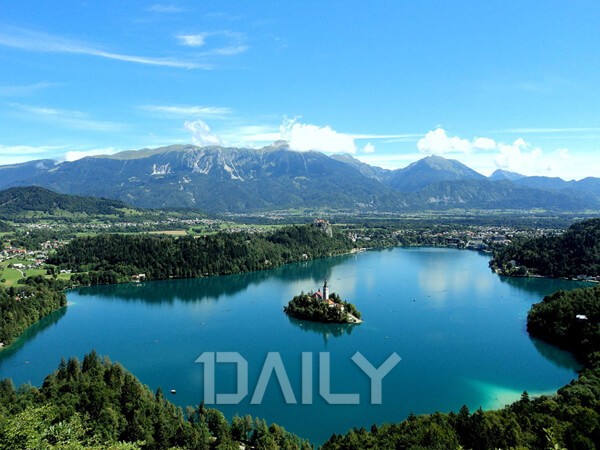There are limited areas in the inland where you can see a lot of water. Areas where you can heal by looking at the water are therefore sought by many and often become tourist attractions. Many lakes worldwide have secured their positions as renowned tourist sites with the gathered water in the inland basins. Some have had their landscapes ruined due to human influence, but many continue to attract visitors with their beautiful scenery. Let’s look at some of these famous lakes from around the world.
Lake Retba, Senegal

In the northern region of Dakar in Senegal, Africa, there is a place called Lake Retba that many people visit. Lake Retba is translated as “Rose Lake.” This major tourist spot in Senegal is a unique lake with a rosy hue like its name. The lake has a salinity level of more than ten times that of the ocean. Plankton living in this high-salinity environment produce red pigments through photosynthesis, giving Lake Retba its strawberry milk-like pink color.
Yellow Lake, Australia

Located in a village in the Wheatbelt of Western Australia, this salt lake is famous for its fluorescent yellow color. The lake is known to turn yellow due to increased bacteria and algae caused by rising temperatures. This lake in Kondinin, about 124 miles east of Perth in Western Australia, is yellow and turns pink, blue, and sometimes even green, depending on the seasons.
Lake Hillier, Australia

Lake Hillier, located on the western coast of Australia, is also famous for its unique color. The reason for the lake’s pink color has not been definitively determined, but it is speculated to be due to the photosynthesis of plankton, similar to Lake Retba. This place was used for a long period to harvest salt due to its high salinity but now functions solely as a tourist attraction. The water of the lake itself is harmless to the human body regardless of its color, and it is said that swimming is also possible.
Lake Louise, Canada

Lake Louise in Canada is located in Banff National Park in Alberta. It is a place where a glacier spreads out behind the lake, and the glacier is said to be named after Queen Victoria of Britain. The name of Lake Louise also originates from here, derived from Louise Caroline Alberta, the fourth daughter of Victoria. Lake Louise is one of UNESCO’s top ten scenic spots in the world, and its unique watercolor and majestic Rocky Mountain terrain make it an impressive tourist attraction.
Flathead Lake, USA

Flathead Lake in Montana, USA, is famous as one of the clearest lakes in the world. Its maximum depth reaches 370 feet, and the average is 164 feet. However, because the water is so clear that it appears shallow, it is known as a place where drowning accidents occur frequently, with many people just going in. Flathead Lake is a freshwater lake formed naturally when glaciers block a river.
Lake Kelimutu, Indonesia

Indonesia’s Kelimutu Mountain is famous for its beautiful three-colored lake. The color of the lake here is known to change unpredictably. It is occasionally blue, green, black, white, or red. This is known to occur due to a chemical reaction caused by the mineral content in the volcanic activity of Kelimutu Mountain. Kelimutu Volcano is also known as the place that was once featured on Indonesian banknotes.
Lake Como, Italy

Lake Como in Italy is a glacial lake in Lombardy. The lake, shaped like a Y, has an area of 56 square miles, making it the third largest lake in Italy after Lake Garda and Lake Maggiore. With a depth of 1,640 feet, it is also the fifth deepest lake in Europe. It is a famous tourist spot known for its beautiful scenery, windsurfing, and sailing, and it is also renowned for having many beautiful villas from the Roman era nearby. Thanks to the mild climate, many gardens decorated with various plants are located around the villas on the lake.
Lake Wakatipu, New Zealand

Lake Wakatipu is located in the inland of the South Island of New Zealand and is known as the longest lake in New Zealand, with a length of about 50 miles. It is a geographical feature where water fills the U-shaped valley carved by a glacier, and the lake forms a long N shape. It is also known for the beauty of its scenery surrounded by mountains, and the Remarkables mountain range is located just south of the lake. You can enjoy skiing, bungee jumping, tramping, and trekking there.
Lake Baikal, Russia

Located in the southern part of Siberia in Russia, Lake Baikal is the world’s largest and deepest freshwater lake. Its average depth reaches 2,537 feet. Known as the largest freshwater lake in Asia, it is so transparent that you can see down to 25 miles, earning it the nickname “the Blue Eye of the Eart.” However, due to unusual phenomena of unknown causes, environmental destruction is progressing, and President Putin visited and emphasized the restoration of this place as a “nationally prioritized task.”
Lake Bled, Slovenia

Lake Bled in Slovenia is called the “Pearl of the Alps.” Along with Lake Bohinj, it is a glacial lake formed by the meltwater of the Alpine icecaps. The lake is beautiful, but Bled Island and Bled Castle, located in the center of the lake, make it look like something out of a fairy tale. Bled is also a popular destination for couples. It is a favorite date spot for Slovenians to visit with their significant other at least once.
By. Deok Soo Choi










Most Commented